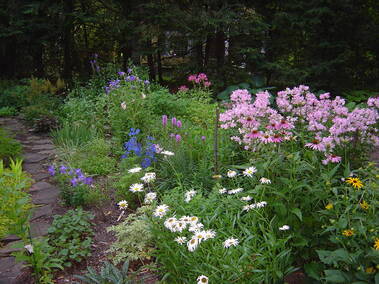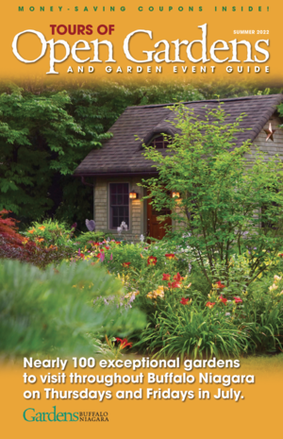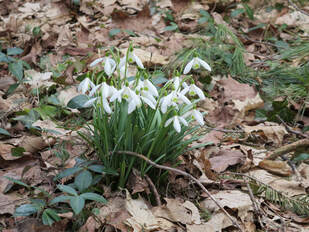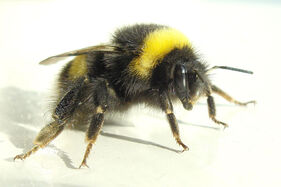AuthorLyn Chimera is a Master Gardener, consultant and lecturer. Archives
May 2023
Categories |
Back to Blog
Gardening is Good for You!10/2/2022  By: Lyn Chimera There are so many reasons that gardening is good for you. Recently I was invited to give a presentation on the topic, and the research I did made me realize just how very many ways there are. Not only do you get beautiful flowers and/or yummy vegetables it’s great for your physical and mental wellbeing. For me, gardening helps keep me centered. It’s very relaxing while at the same time it can be hard work which helps work out stress and frustrations. While gardening you focus on what you’re doing and forget about what’s bothering you. Even weeding can almost be meditative and it sure is satisfying once you’re finished. Another benefit is that inhaling a naturally occurring bacteria in the soil M.vaccae, can release serotonin which reduces anxiety. Besides relieving stress, gardening is good for you in other ways. It helps build strength and flexibility. Hand strength improves from using pruners, a trowel, shovels, gripping any tools, wheelbarrow handles etc.. It’s hard to do any gardening without using your hands. Your back gets lots of exercise from bending and lifting for all sorts of chores which really helps strengthen those muscles. When my back gets a little tired from all that bending, I stand up and flex my spine back like a mini backbend then do a yoga move called scrape the barrel where you rotate your hips as if you were scraping the inside of a barrel. Both these stretches help relieve back strain and help avoid a sore back. Gardening also makes you stronger. Hauling watering cans, hoses, digging, and all garden chores improve strength. Gardening is an excellent low impact exercise. Studies have shown that people stick with gardening much more than they stick to going to a gym and you don’t have a monthly fee! General gardening can burn 330 calories per hour. It would be more for more strenuous garden work like mowing (not a riding mower), digging, raking etc.. While outside gardening you are exposed to vitamin D through sunshine. Vitamin D helps increase calcium and makes bone stronger. It also boosts your immune system. However, don’t forget to use sunscreen. Another benefit of gardening is it gets you outside and away from electronics and screens. This relieves eye strain and gives your brain a rest. Try trading your blackberry for blackberry bushes! Growing fruits and vegetables dramatically improves your diet. Fresh produce is much more nutritious and healthier for you. You can control and hopefully eliminate the pesticide and herbicide use. Besides it tastes much better. People who grow vegetables tend to include more vegetables in their diet which is another benefit to your health. Children involved with growing food are much more willing to try things and will eat vegetables they might not ordinarily. If you happen to have back and or knee problems, you can still enjoy gardening. Raised beds, some can be as tall as tables, allow you to garden with little to no bending. Planters and even window boxes can be used to grow food or flowers. Knee pads or movable foam pads are very helpful for sore knees. I’ve used both and preferred knee pads that wrap around your knees. That way you don’t have to move the foam pad from place to place. Bench seats are also available. Some are 2-sided, one side for a kneeling pad and when it's turned over it becomes a raised seat. The legs form a bar for helping you get up. Therapeutic gardens have been used for centuries. The original Richardson Complex on Elmwood Ave in Buffalo was an asylum for people with mental problems. Working outside in vegetable and flower gardens was part of everyone’s therapy. Many prisons have gardens where prisoners can learn skills that could be turned into employment once released. These gardens also help calm prisoners and generally improve their behavior. My mother was in a nursing home where they had a courtyard garden which gave her hours of pleasure. She didn’t remember a lot but once in the garden she knew what to do. It was amazing to watch. Don’t worry if you have no access to a garden, just being outside in nature can improve your mood, health, and wellbeing. So let nature help you relax and enjoy nature’s beauty.
0 Comments
Read More
Back to Blog
July is for Visiting Gardens7/11/2022  By: Lyn Chimera For those of you, like myself, who have been waiting all winter for July when we can visit some of the best gardens in the country, the wait is over. The month of July in Western New Yok is all about gardens and gardening. The gardening events begin in June with the Lewiston Gardenfest, 6/18&19 and The Buffalo Style Garden Art Sale at the Botanical Gardens 6/25&26. However, it’s the month of July that is packed full of garden visit opportunities. The best way to learn about all the events is to get the booklet, Open Gardens, published by Gardens Buffalo Niagara. It is available at many nurseries and the low cost of $10. Check out their website for full details: https://www.gardensbuffaloniagara.com/ There are three major opportunities for visiting local gardens during July: Open Gardens The advantage of Open Gardens is you don’t have the crowds to deal with like during Garden Walk Buffalo and parking is not an issue. There are over 100 private gardens open to the public on Thursdays and Fridays from July 7th through the 29th covering Erie and Niagara Counties. Some are open both days, some all of one of the days and others part of one of the days. There are even some gardens open at night. All are free. The gardens are divided into 9 geographic sections such as Northtowns East and West, Buffalo and Southtowns Bouquet. The Open Gardens booklet has complete listings including maps and information about the gardens and points of interest in the area. Unfortunately my gardens will not be on this year. Community Garden Walks Fourteen local communities are sponsoring neighborhood Garden Walks during four weekends in July beginning July 9th. The Open Garden book or their website tells which areas like Hamburg, Lancaster and Grand Island are open when and where to get the maps. Each community puts out their own map with directions and descriptions of the gardens. The tours are self-guided. Most are free but some ask for a donation. This is a lovely way to spend a day or afternoon getting to know a community. Garden Walk Buffalo July 30 & 31, 10 AM – 4 PM. This is the highlight and biggest draw of the month. The Buffalo Garden walk has evolved into the largest garden tour in America. Tens of thousands of people come from all across the country to see our amazing gardens. It has become the garden event of the year written up in national gardening magazines. There are hundreds of private and public gardens throughout the city open on these 2 days. Maps are available at various locations and at the Garden Walk website. www.gardensbuffaloniagara.com/garden-walk-buffalo Some tips for any of the garden visits:
Wear comfortable shoes and dress for the weather. Some gardens have stone walkways, paths with roots or other difficult walking situations. Also, grass may be wet and slippery. The gardens are open rain or shine so plan to dress appropriately. Take your camera/cell phone to take pictures. After seeing many gardens you’ll want to remember some of the pants you liked, landscaping ideas, garden art etc. Trust me, after seeing 8-10 gardens it’s hard to remember where you saw what or what it was. Don’t be hesitant to talk to the owners and ask questions. You’ll be seeing some plants you might not recognize or wonder how much work is involved in their garden, how long did it take to develop, helpful tips etc.. Be mindful of people’s property and stay on paths or designated areas. It’s easy to be distracted by a beautiful plant or whatever and step where you shouldn’t. Your garden touring experience will be much more enjoyable if you plan a strategy. Get the Open Gardens booklet or download maps from the website to plan your route. Don’t forget to plan a lunch break or shopping jaunt. It’s a delightful way to spend a day with like minded gardening fiends. I guarantee you will get some good ideas. Hope to see you soon!
Back to Blog
July 2022 Tips7/1/2022
*|MC_PREVIEW_TEXT|*
Back to Blog
May 2022 Plant Sale5/15/2022
*|MC_PREVIEW_TEXT|*
Back to Blog
May '22 Tips5/2/2022
*|MC_PREVIEW_TEXT|*
Back to Blog
April 2022 Tips4/1/2022
*|MC_PREVIEW_TEXT|*
Back to Blog
May 2022 Plant Sale3/31/2022 Dear Gardening Friends,
The annual Lessons from Nature Perennial and Native Plant Sale will be Saturday, May 21 from 9-2. Clients and those receiving these tips can come at 8 and avoid the crowds. The sale is located at my home at 170 Pine Street in E Aurora. Clients and those receiving these tips can come at 8 and avoid the crowds. Once again Ellen Foltz from Amanda’s Garden will bring her self propagated natives. Plants available will be listed in the May Garden Tips. Put the date on your calendar!
Back to Blog
Thoughts on Spring Improvements3/31/2022  Thoughts on Spring Improvements By: Lyn Chimera Who doesn’t look forward to spring? It’s not just because it means the cold and snowy weather of winter is behind us. Spring’s reawakening is natures promise that life goes on. How wonderful it will be to see the first daffodils and crocus. Spring is the season for optimism. To me spring is almost like the New Year, time to make resolutions for improvement in my gardens. Lots of us are planning what to add, remove or change. There is so much in the news about pollinator, songbird, and insect decline along with climate change why not make improvements this spring that can help alleviate these problems. I recently attended the annual Ithaca Native Landscaping Symposium (via Zoom). The major focus of the Symposium was what the average homeowner can do to help support not just pollinators but other beneficial insects, birds, and nature in general. The number one thing you can do is stop using insecticides/pesticides. First, there is no insecticide that only kills the bad guys. Any insect that eats that pant or gathers its pollen or nectar will be affected. Since over 90% of the insects in our gardens are beneficial just the thought of killing all insects is counterproductive. Beneficial insects not only pollinate but help control harmful insects by eating or parasitizing them. Since I stopped using pesticides, at least 30 years ago, my gardens are a buzz with beneficials, and I have very little problem with the bad guys. When the Japanese beetles arrive, I knock them into soapy water and that really helps. Improving soil is the key to healthy plants. Chemical fertilizers, the ones you mix in water, may feed the plants but are harmful for the soil. People don’t realize it, but healthy soil is full of life from worms and bugs you can see to billions of microscopic creatures you can’t see. It’s the soil life, its decomposition and excrements, that provide nutrients for plants. Think about it…no one “feeds” the soil in the meadows and woods and those plants grow very well. So, what can you do? Add organic matter instead of chemical fertilizers. Compost is the best way to improve your soil’s nutrition and texture. Compost is filled with microbial life which will inoculate your soil. It’s easy to add a little to every planting hole. About 1/3 compost with 2/3 of the existing soil is a good ratio. Compost can also be used as a mulch. It’s not necessary to work it into the soil. Simply leave it on the top as a mulch would be and nature will take care of distributing the nutrients. Compost is the best thig to add to clay soil. In fact, there is nothing in your gardens that can’t be helped by using compost. When the plants are healthier, they are more resistant to insect and disease problems. You can make your own compost or purchase it bagged or by the yard from local nurseries. If purchasing bags read the ingredients and make sure it doesn’t contain topsoil or anything else as filler. When purchasing from a nursery ask about the ingredients. Compost should never be smelly. If it is, don’t buy it. Leaves are another excellent soil amendment. After a few years of using compost as mulch I now just use mulched leaves that I gather in the fall. It’s the best mulch and it’s FREE! Another important thing you can do to support nature is plant native plants. The connection between plants that evolved in our area to the beneficial insects, birds and animals that also evolved here is crucial for a productive habitat. Not only do native pants provide pollinators with the nectar they need they serve as host plants for the larva of beneficial insects including butterflies. Don’t think you have to rip out your nonnative plants and start over. If you need a plant for a spot or are replacing one that died, look for a native that’s right for that site. Here comes the tricky part. Most “natives” found in nurseries have been hybridized for color, size, or other features to please gardeners. Often, they no longer provide the food native insects and birds need because they are sterile. When buying a native look up the botanical name and ask for that. If there is a common name after the botanical name that means, it’s a cultivar. There are nurseries that sell the true species so ask for them. The more people request the true species the more nurseries will carry them. If you have trouble finding a plant, check online but always try local independent nurseries first. Happy Gardening!
Back to Blog
March 2022 Tips3/1/2022
*|MC_PREVIEW_TEXT|*
Back to Blog
February 27th, 20222/27/2022  The Amazing Bumblebee By Lyn Chimera Recently I was asked to compile some interesting information about bumblebees, in the genus Bombus, for an informational flyer Master Gardeners could use as a handout at various events like Plantasia (March, 16-20). They are such fascinating little critters I wanted to share some of what I learned. First of all, Bumblebees are large (about an inch) yellow and black flying insects native to the US. They have 4 wings. The two rear wings are smaller than the front wings and the wings beat at a rate of 130-240 beats per second. There are about 46 varieties of bumblebees in N America and over 250 known varieties worldwide. Bumblebees are our only native bee that lives in colonies. They prefer to live in cavities like dead trees and abandoned nests. Their favorite nesting site, however, is an abandoned rodent tunnel because it’s warm and already lined with fur. Sounds cozy to me. Their colonies range in number from 50 to 500. Bumblebees only live for one year. In the fall new queens are hatched and spend the winter in a protected area then start new colonies in the spring. Because the bumblebees don’t overwinter, they don’t need to store food. The nectar and pollen they gather goes to feed themselves and their young. As pollinators go bumblers are much more efficient than honeybees. This is due in part to their hairy bodies which spread the pollen more effectively. They also “buzz pollinate” which means they vibrate their bodies as they come in contact with a flower to cause even more pollen distribution. One of the most interesting facts about their pollination is they leave a scent marking on each flower they pollinate. This alerts other bumblers that the flower had been pollinated so go on to another. How efficient! The reason they are so favored by agriculture and nature is that they are generalists rather than specialists. Bumblers will gather from a variety of species at the same time. In addition, due to their built in “fur coat” they can fly and pollinate earlier in the spring and later in the fall than many other pollinating insects. They also have an amazing tongue that is often longer than a honeybee’s so they can get nectar from a wider variety of flowers. By the way their tongue is also their sense organ for taste and smell. Worker bumblebees have the job of gathering nectar for carbohydrates and pollen for protein. They are real workhorses flying a mile or further to gather food. The average worker carries 25% of their body weight in pollen and nectar. Some have been measured to carry 75% of their body weight. That would be like a 150 pound person carrying 37.5 lbs. or up to 122 lbs.! Now that’s impressive. I must admit I love watching bumblebees in my garden. They won’t sting unless threatened so are safe to watch form close up. Often you will find one in the early morning sleeping on a flower. Honeybees will do this as well. In my garden native turtle head (Chelone obliqua) is one of their favorite flowers. Because of the shape of the flower the bumbler has to wiggle its way into the petals to get to the pollen and nectar. Always entertaining to watch. What can you do to help protect bumblebees and basically all pollinators? Plant a variety of native and pollinator attracting flowers covering a span of seasons and encourage neighbors to do the same. Destruction of habitat is one of the contributing factors in the demise of bumblebees. Avoid using pesticides particularly the systematic ones that persist throughout the plant. These toxins effect the whole plant including the pollen and nectar and kill all insects including pollinators. Not using pesticides and herbicides is one of the best ways any home gardener can help the ecology. Never harm a bumblebee; they are our friends. |

 RSS Feed
RSS Feed


